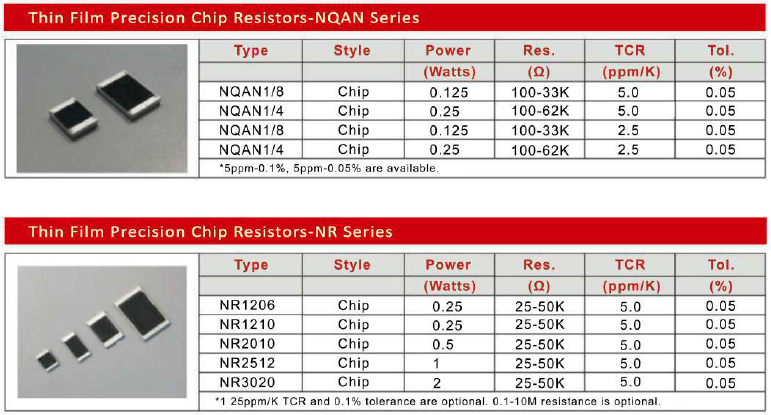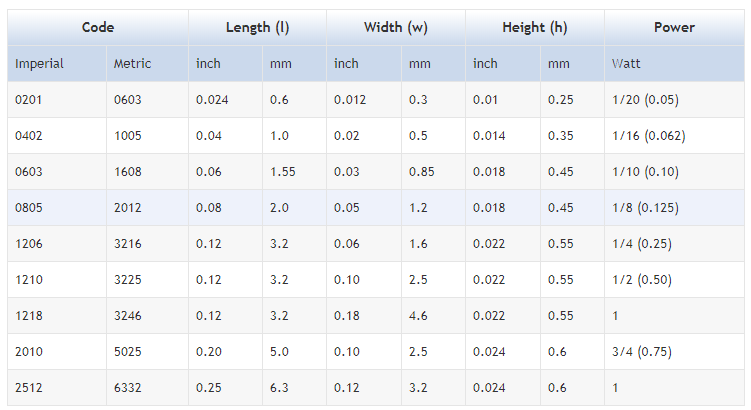Position:Home » Technical Articles
Surface Mount Resistor's Sizes
Writer:Microhm Page View:Date:2019-05-10
Resistors are available in a large amount of different packages. Nowadays the most used are the rectangular surface mount resistors, which mainly consist of thin film resistors and thick film resistors.
Thin film resistors and thick film resistors are characterized by a resistive layer on a ceramic base. Although their appearance might be very similar, their properties and manufacturing process are very different. The naming originates from the different layer thicknesses. Thin film has a thickness in the order of 0.1 micrometer or smaller, while thick film is around thousands time thicker. However, the main difference is method the resistive film is applied onto the substrate. Thin film resistors have a metallic film that is vacuum deposited on an insulating substrate. Thick film resistors are produced by firing a special paste onto the substrate. The paste is a mixture of glass and metal oxides.

The shape and size of surface mount resistors are standardized, most manufacturers use the JEDEC standards. The size of SMD resistors is indicated by a numerical code, such as 0603. This code contains the width and height of the package. So in the example of 0603 Imperial code, this indicates a length of 0.060″ and a width of 0.030″. This code can be given in Imperial or Metric units, in general the Imperial code is used more often to indicate the package size. On the contrary in modern PCB design metric units (mm) are more often used, this can be confusing. In general you can assume the code is in imperial units, but the dimensions used are in mm. The SMD resistor size depends mainly on the required power rating. The following table lists the dimensions and specifications of commonly used surface mount packages.

Thin film resistors and thick film resistors are characterized by a resistive layer on a ceramic base. Although their appearance might be very similar, their properties and manufacturing process are very different. The naming originates from the different layer thicknesses. Thin film has a thickness in the order of 0.1 micrometer or smaller, while thick film is around thousands time thicker. However, the main difference is method the resistive film is applied onto the substrate. Thin film resistors have a metallic film that is vacuum deposited on an insulating substrate. Thick film resistors are produced by firing a special paste onto the substrate. The paste is a mixture of glass and metal oxides.

The shape and size of surface mount resistors are standardized, most manufacturers use the JEDEC standards. The size of SMD resistors is indicated by a numerical code, such as 0603. This code contains the width and height of the package. So in the example of 0603 Imperial code, this indicates a length of 0.060″ and a width of 0.030″. This code can be given in Imperial or Metric units, in general the Imperial code is used more often to indicate the package size. On the contrary in modern PCB design metric units (mm) are more often used, this can be confusing. In general you can assume the code is in imperial units, but the dimensions used are in mm. The SMD resistor size depends mainly on the required power rating. The following table lists the dimensions and specifications of commonly used surface mount packages.

Keywords:
Latest News
- Resistor's role in measuring and correcting LED,,,
- Single through-hole resistors' characteristics ,,,
- Why shunt resistors for current sense applicati,,,
- Metal-film resistors with small size, high resi,,,
- 36W High-Current Shunt Resistors MMS8420,,,
- 1W Surface Mount Resistor MPR1206,,,
- An Overview of Microhm Electronics' Resistor Pr,,,
- More anti-sulfur resistors used in harsh envir,,,
- Resistance changes with temperature,,,
- 140W TO247 High Power Heatsinkable Resistor,,,
- MMS5930 is ideal for current sensing in industr,,,
- Shunt resistors selection for engineers' design,,,
- Considerations for choosing precision resistors,,,
- Ceramic Encased Cement Resistors NWH Series for,,,
- Resistors for Passive Balancing in Battery-Pow,,,
Hot Articles
- Microhm will take part in 10th Automotive World,,,
- Thanks for Visiting Microhm's Booth E5-5706 in ,,,
- Resistors in Short Supply: Blame Cars,,,
- New lunch: High Power Precision Shunt Resistor,,,,
- How to Test a Resistor,,,
- Innovative Technology, Future Electric: Electri,,,
- What is Precision Resistors?,,,
- SMD Resistors Sizes and Packages,,,
- The Construction and Features of Metal Film Res,,,
- What is a TO-220 Resisor?,,,
- Hot Selling Products: Precision Shunt Resistors,,,
- How to Calculate the Equivalent Resistance Valu,,,
- What is a Fixed Resistor?,,,
- Resistors in LED Circuits,,,
- Resistors Types and Materials Overview,,,
Resistance applications
- Select the Right Resistor for Harmonic Filterin,,,
- Miniature future for passive electronic compone,,,
- BMS for New Energy Vehicle,,,
- Surface Mount Resistor's Size and Package ,,,
- Shunt Resistor MMS8420 for High Current Stable ,,,
- The Four Important Functions of Alloy Resistors,,,
- Precision Resistors' Construction and TCR,,,
- Difference Between High Precision Resistors and,,,
- Urbanization Development Bringing the Transform,,,
- Carbon Film Resistors' Features and Application,,,
- The Main Application for High Precision and Low,,,
- Why Zero-Ohm Resistors?,,,
- Industrial Roberts Applied to Solar Photovoltai,,,
- The Measurement Accuracy of Automotive Shunt is,,,
- Heater Blower Motor Resistor in Air Conditioner,,,
